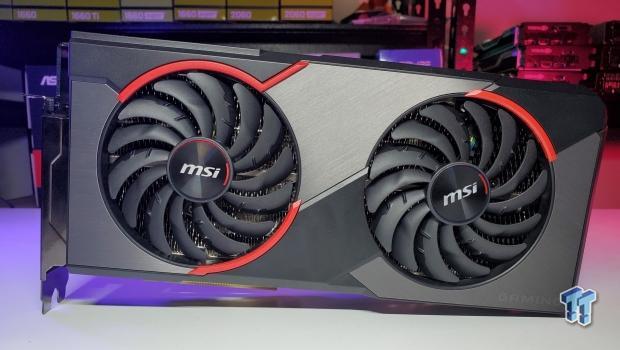
The Bottom Line
Introduction
Note: MSI could not help the new BIOS or last-minute changes from AMD. I hold no ill feelings towards MSI for that, as it was all AMD. I'm not going to punish MSI or AMD in my final charts, but it will make it into the bottom line of this review. AMD -- learn from this, you're hurting AIB partners and gamers and haven't even really apologized for this gigantic cock up. You jebaited yourselves.
We all know AMD had quite a troubled launch with the Radeon RX 5600 XT, so much so that I wrote an entire article about it. The first samples that arrived in my lab were from SAPPHIRE and MSI, with my review of the SAPPHIRE Radeon RX 5600 XT PULSE OC graphics card up and online, it's time to move onto the MSI Radeon RX 5600 XT GAMING X -- well, GAMING Z -- once you're finished flashing the BIOS.
MSI's new Radeon RX 5600 XT GAMING X is exactly what you expect -- an all-class custom Radeon RX 5600 XT that is another great member of the ever-expanding GAMING X family of graphics cards from MSI. It packs a Navi GPU, 6GB of now-faster GDDR6 memory, all of the goodies that AMD includes in the RDNA architecture, and more.
The performance between all of the custom cards is pretty damn close to one another, so you'd be buying the MSI over another custom card from a different AIB because of your allegiance to MSI, I guess. There's not much left to do inside of the card with GPU and VRAM clocks, so you'd probably buy it for its visual aesthetics over anything else -- something MSI does extremely well with its GAMING X branded graphics cards.
Pricing
AMD launched its new Radeon RX 5600 XT starting at $279, but at the time of writing MSI's Radeon RX 5600 XT GAMING X was priced at $329. MSI's own Radeon RX 5700 MECH OC is just $349 in comparison, where you'd be getting a slightly faster card but 8GB of GDDR6 (versus 6GB on the RX 5600 XT) for $20 more. Something to consider.
Detailed Specs
The full list of detailed specs on the MSI Radeon RX 5600 XT GAMING X, while the newly-introduced MSI Radeon RX 5600 XT GAMING Z is identical, but rocks the new BIOS out-of-the-box. No need for a pesky, annoying, time-consuming (and frankly unnecessary if AMD didn't "jebait" themselves) task.
Cooling Tech
Cooling Tech: TWIN FROZR 7
Most gamers will know about MSI's iconic TWIN FROZR cooling technology by now, but if not -- here's the run down. MSI uses its slick black and gunmetal grey styling on its GAMING X branded cards which looks awesome in a PC, with great RGB lighting effects that aren't too over-the-top, either.
The brushed look on the back plate looks great, but it also protects the back of the card from any damages -- not just that, but MSI has placed thermal pads to keep the temperatures lower on your new Radeon RX 5600 XT GAMING X, too.
Another nice, and very small trick MSI has done with the Radeon RX 5600 XT GAMING X and its TWIN FROZR 7 cooler is the 'SPACED ARMOR'. This sees MSI increasing the space between the backplate and the PCB so that more air can flow through the gap, cooling the card down even more -- even if its another 1-2C, every little bit matters.
MSI uses some kick ass copper heat pipes here.
The same Torx 3.0 fans are used on the new Radeon RX 5600 XT GAMING X.
The fans won't spin up until the GPU gets to over 60C, thanks to MSI's own ZERO FROZR technology that has been around since 2008.
MSI uses a dedicated aluminum plate that covers the power delivery components, which are becoming more and more important over the years.
MSI has 'mastered the art of Aerodynamics'.
MSI puts some serious love and care into their GAMING X graphics cards and TWIN FROZR 7 cooling.
This is how the card keeps so cool.
More on that with the GPU baseplate.
MSI uses Thermal Compound X on its GAMING X series graphics cards.
The company also uses thermal padding on the GDDR6 memory and VRMs.
Detailed Look
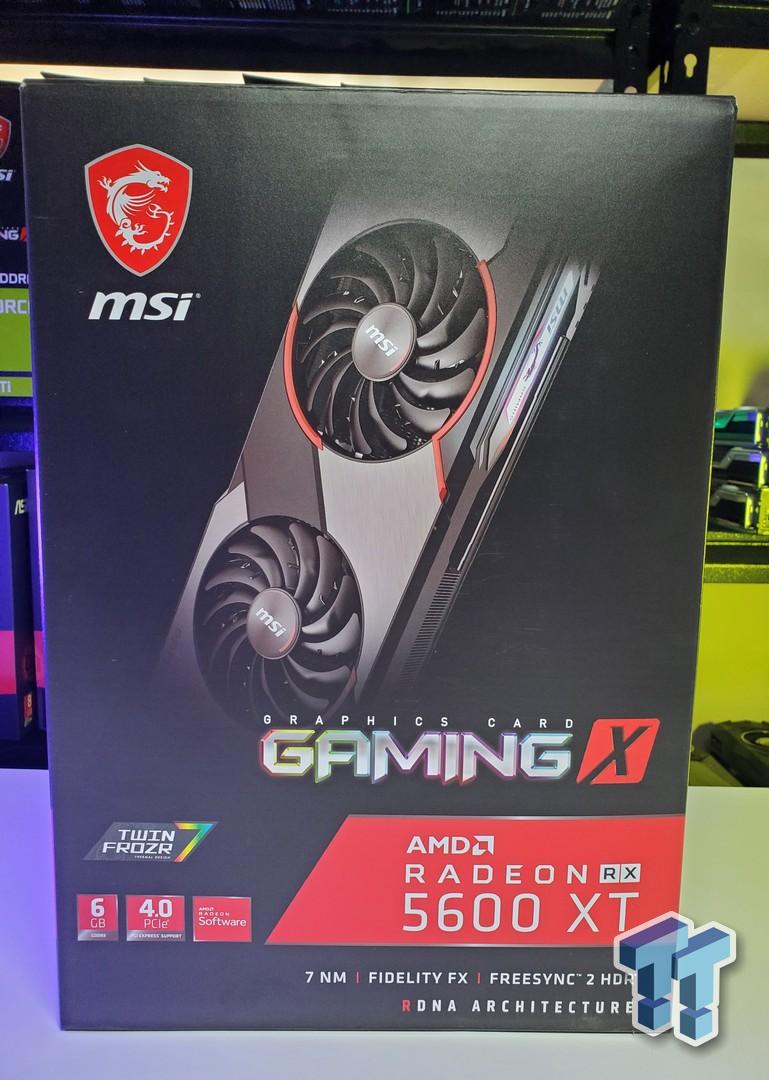
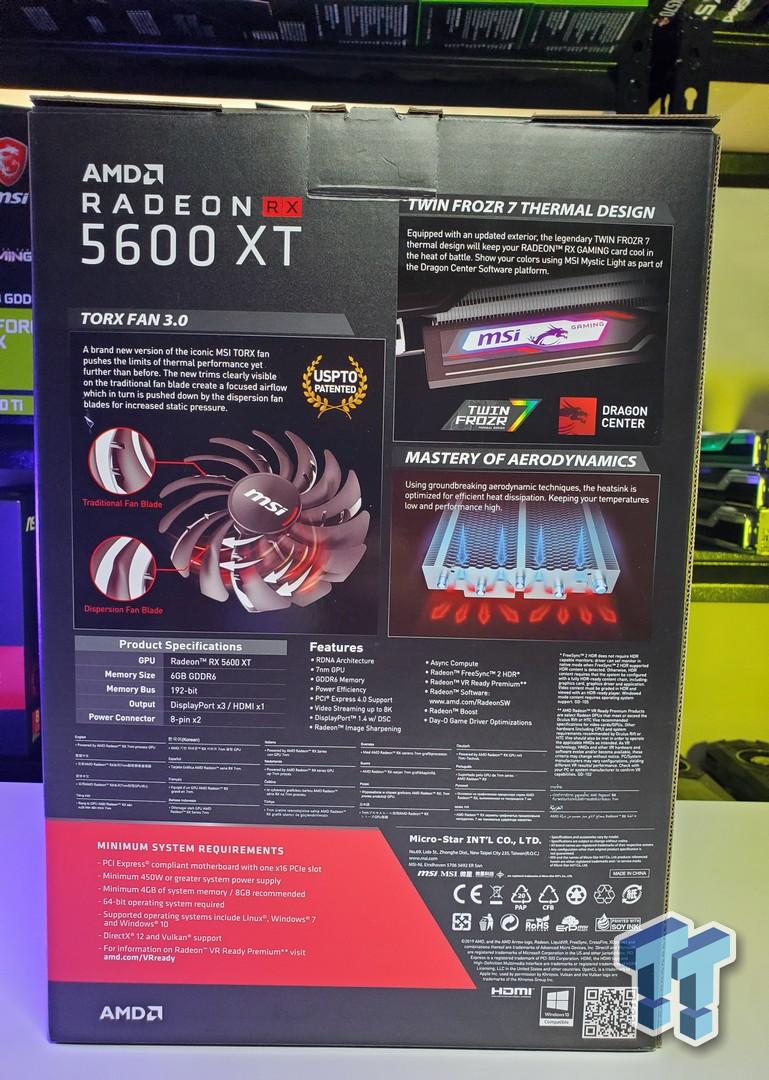
MSI's iconic TWIN FROZR 7 is no strnager to PC gamers, with the mid-range Radeon RX 5600 XT GAMING X getting the TWIN FROZR 7 cooling tech treatment -- and as usual, it looks -- and performs beautifully.
The visual style of the card looks great for a mid-range offering at $329, with a slick red trim around the fans -- the fan on the left gets more of the trim, while on the right it is finished off. I love this look, and it looks great with some RGB lighting reflecting off of it inside of a gaming rig.
MSI has always had great-looking backplates and the Radeon RX 5600 XT GAMING X is no different -- the brushed aluminum style with design aesthetics that pop, is a great addition to a 'mid-range' $329 graphics card.
You will have the usual 3 x DisplayPort + 1 x HDMI 2.0 output on the MSI Radeon RX 5600 XT GAMING X.
Strangely, you'll need dual 8-pin PCIe power connectors on the card -- and by strange, I mean really strange as the SAPPHIRE Radeon RX 5600 XT PULSE OC requires just a single 8-pin PCIe power connector in comparison and has virtually identical performance to the MSI variant.
From the bottom of the card you can see MSI's super-thick heat sink work, making it a 2.5-slot graphics card.
Once again from the top, with the MSI Gaming RGB lighting/logo at the front of the card.
Test System Specs
GPU Test Rig Specs
Welcome to the latest revision of our GPU test bed, with our system being upgraded from the Intel Core i7-7700K to the Core i7-8700K. The CPU is cooled by the Corsair H115i PRO cooler, with the 8700K overclocked to 5GHz. We've stayed with GIGABYTE for our motherboard with their awesome Z370 AORUS Gaming 7.
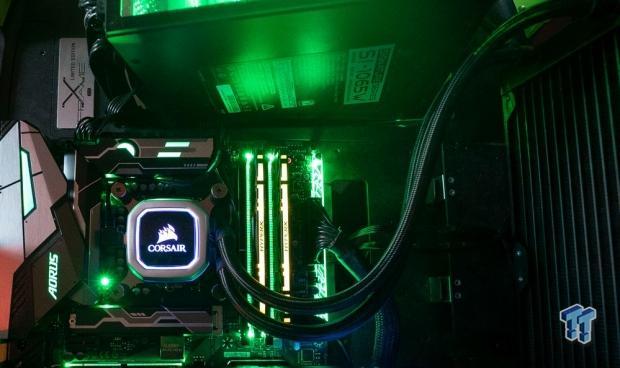
We approached our friends at HyperX for a kit of their kick ass HyperX Predator DDR4-2933MHz RAM (HX429C15PB3AK4/32), with 2 x 8GB sticks for a total of 16GB DDR4-2933. The RAM stands out through every minute of our testing as it has beautiful RGB lights giving the system a slick look while benchmarking our lives away, while the Z370 AORUS Gaming 7 motherboard joins in with its own array of RGB lighting.
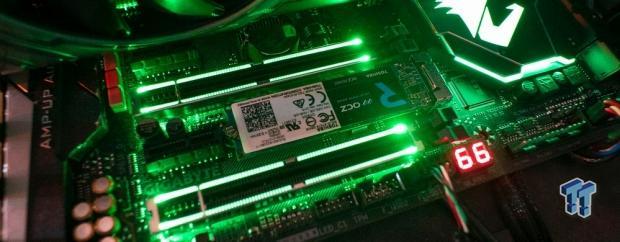
Detailed Tech Specs
- CPU: Intel Core i7-8700K @ 5GHz
- Cooler: Corsair Hydro Series H115i PRO
- MB: Z370 AORUS Gaming 7
- RAM: 16GB (2x8GB) HyperX Predator DDR4-2933
- SSD: 1TB OCZ RD400 NVMe M.2
- SSD: 512GB OCZ RD400 NVMe M.2
- PSU: InWin 1065W PSU
- Chassis: In Win X-Frame
- OS: Windows 10 Pro x64
Additional Images
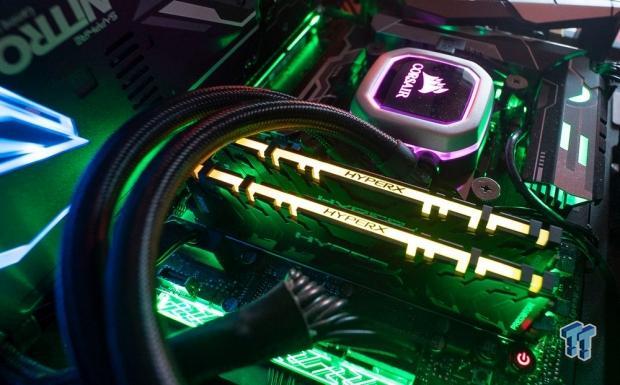
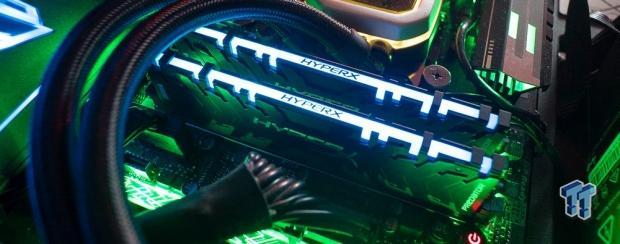
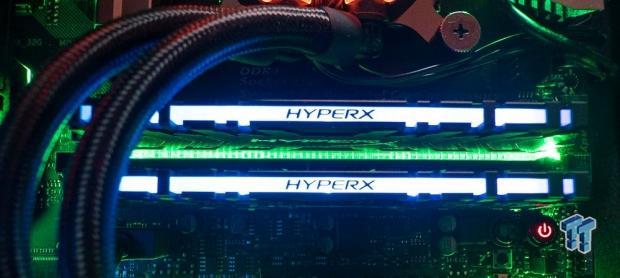
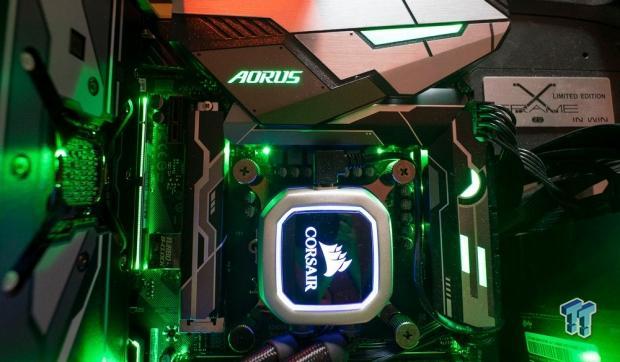
Benchmarks - Synthetic
3DMark Fire Strike - 1080p
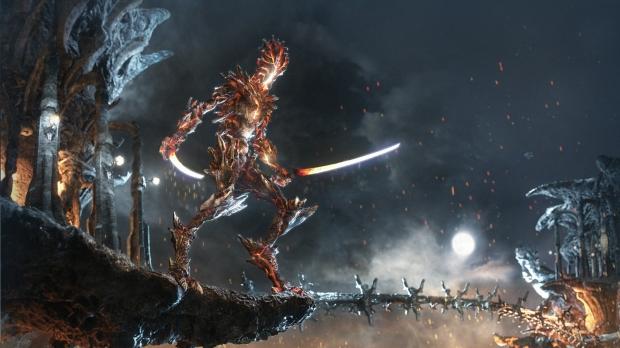
3DMark has been a staple benchmark for years now, all the way back to when The Matrix was released and Futuremark had bullet time inspired benchmarks. 3DMark is the perfect tool to see if your system - most important, your CPU and GPU - is performing as it should. You can search results for your GPU, to see if it falls in line with other systems based on similar hardware.
3DMark Fire Strike - 1440p
3DMark has been a staple benchmark for years now, all the way back to when The Matrix was released and Futuremark had bullet time inspired benchmarks. 3DMark is the perfect tool to see if your system - most important, your CPU and GPU - is performing as it should. You can search results for your GPU, to see if it falls in line with other systems based on similar hardware.
3DMark Fire Strike - 4K
3DMark has been a staple benchmark for years now, all the way back to when The Matrix was released and Futuremark had bullet time inspired benchmarks. 3DMark is the perfect tool to see if your system - most important, your CPU and GPU - is performing as it should. You can search results for your GPU, to see if it falls in line with other systems based on similar hardware.
3DMark TimeSpy
3DMark TimeSpy Extreme
Heaven - 1080p
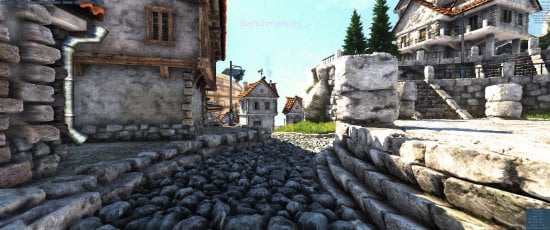
Heaven is an intensive GPU benchmark that really pushes your silicon to its limits. It's another favorite of ours as it has some great scaling for multi-GPU testing, and it's great for getting your GPU to 100% for power and noise testing.
Heaven - 1440p
Heaven - 4K
Benchmarks - 1080p
1080p Benchmarks
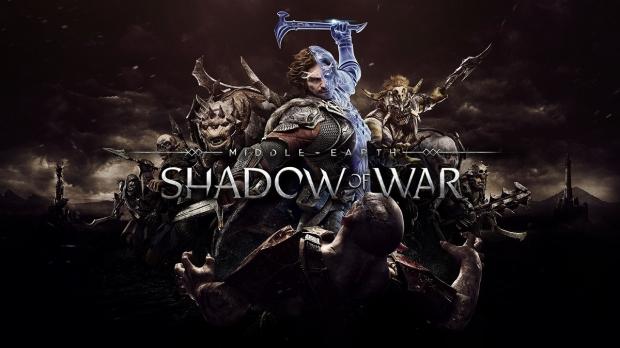
Middle-earth: Shadow of War is a sequel to the popular Shadow of Mordor, which was powered by the Lithtech engine. When cranked up to maximum detail, it will chew through your GPU and its VRAM like it's nothing.
You can buy Middle-earth: Shadow of War at Amazon.
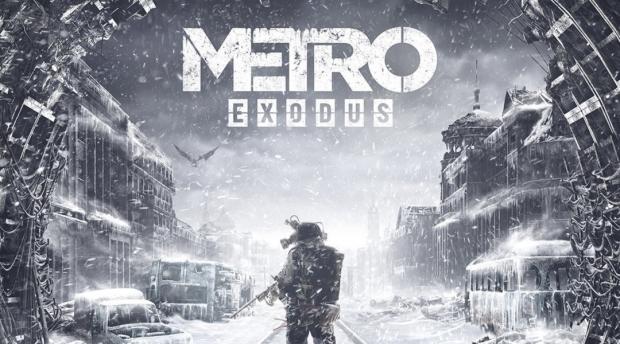
Metro Exodus is one of the hardest tests that our graphics cards have to go through, with 4A Games' latest creation being one of the best looking games on the market. It is a serious test that pushes GPUs to their limits, and also features RTX technologies like DLSS.

Far Cry New Dawn was developed by Ubisoft, and is powered the Dunia Engine, an engine that has been modified over the years for Far Cry and last used in Far Cry 5. Dunia Engine itself was a modified version of CRYENGINE, scaling incredibly well on all sorts of hardware.

Shadow of the Tomb Raider is one of the latest games to join our graphics card benchmark lineup, with the game built using the Foundation engine as a base, the same engine in Rise of the Tomb Raider. Eidos Montreal R&D department made lots of changes to the engine during the development of Shadow of the Tomb Raider to make it one of the best-looking games out right now.
1080p Benchmark Performance Thoughts
This is where you'll be buying the MSI Radeon RX 5600 XT GAMING X -- 1080p gaming. It enjoys virtually identical performance to every other Radeon RX 5600 XT, with the last-minute BIOS changes from AMD seeing MSI add a sprinkling of performance on top that edges the card out from the slower BIOS.
We have 10FPS more performance in Shadow of War which is a memory bandwidth intensive test, where before the BIOS update MSI's new Radeon RX 5600 XT GAMING X was losing to the GTX 1660 Ti GAMING X, but after the BIOS upgrade it was beating that card, and the 1660 SUPER GAMING X.
Post-BIOS update the MSI RX 5600 XT GAMING X was beating the RTX 2060 from NVIDIA, as well as the HBM2-based Radeon RX Vega 56 from AMD in Metro Exodus. The suped-up BIOS also helps MSI beat out the RX Vega 56 once again in Shadow of the Tomb Raider at 1080p with another 10FPS average over the old BIOS.
Benchmarks - 1440p
1440p Benchmarks

Middle-earth: Shadow of War is a sequel to the popular Shadow of Mordor, which was powered by the Lithtech engine. When cranked up to maximum detail, it will chew through your GPU and its VRAM like it's nothing.
You can buy Middle-earth: Shadow of War at Amazon.

Metro Exodus is one of the hardest tests that our graphics cards have to go through, with 4A Games' latest creation being one of the best looking games on the market. It is a serious test that pushes GPUs to their limits, and also features RTX technologies like DLSS.

Far Cry New Dawn was developed by Ubisoft, and is powered the Dunia Engine, an engine that has been modified over the years for Far Cry and last used in Far Cry 5. Dunia Engine itself was a modified version of CRYENGINE, scaling incredibly well on all sorts of hardware.

Shadow of the Tomb Raider is one of the latest games to join our graphics card benchmark lineup, with the game built using the Foundation engine as a base, the same engine in Rise of the Tomb Raider. Eidos Montreal R&D department made lots of changes to the engine during the development of Shadow of the Tomb Raider to make it one of the best-looking games out right now.
1440p Benchmark Performance Thoughts
I wouldn't recommend the Radeon RX 5600 XT for 1440p gamers, but if you were playing esports games like Overwatch and Apex Legends then you will have a blast -- for AAA games? If you turned down the details then sure, but for benchmark purposes I run everything maxed out on Ultra graphics (with AA and motion blur disabled).
We have over 60FPS average in Shadow of War with the new BIOS, while the old BIOS lags behind at 54FPS average -- enough to beat the GTX 1660 Ti thanks to the upgraded BIOS. The new BIOS pumps the MSI RX 5600 XT up to 49FPS in Metro Exodus at 1440p, an identical result to the HBM2-based Radeon RX Vega 64.
We also have some great performance at 1440p in Shadow of the Tomb Raider, with 78FPS average -- equal to the Radeon RX Vega 56, and 7FPS more than the old BIOS.
Benchmarks - 4K
4K Benchmarks

Middle-earth: Shadow of War is a sequel to the popular Shadow of Mordor, which was powered by the Lithtech engine. When cranked up to maximum detail, it will chew through your GPU and its VRAM like it's nothing.
You can buy Middle-earth: Shadow of War at Amazon.

Metro Exodus is one of the hardest tests that our graphics cards have to go through, with 4A Games' latest creation being one of the best looking games on the market. It is a serious test that pushes GPUs to their limits, and also features RTX technologies like DLSS.

Far Cry New Dawn was developed by Ubisoft, and is powered the Dunia Engine, an engine that has been modified over the years for Far Cry and last used in Far Cry 5. Dunia Engine itself was a modified version of CRYENGINE, scaling incredibly well on all sorts of hardware.

Shadow of the Tomb Raider is one of the latest games to join our graphics card benchmark lineup, with the game built using the Foundation engine as a base, the same engine in Rise of the Tomb Raider. Eidos Montreal R&D department made lots of changes to the engine during the development of Shadow of the Tomb Raider to make it one of the best-looking games out right now.
4K Benchmark Performance Thoughts
This is where the Radeon RX 5600 XT is punished the most, at 4K -- where starting with Shadow of War it is pumping out just 35FPS which loses to the GTX 1660 Ti and GTX 1660 SUPER graphics cards.
MSI's new Radeon RX 5600 XT GAMING X manages just 30FPS in Metro Exodus at 4K with the new BIOS, while it hits just 39FPS in Shadow of the Tomb Raider. I wouldn't be rushing out to buy any Radeon RX 5600 XT for AAA games at 4K, but for esports games like Overwatch and Apex Legends, you could easily chuck one of these cards in and enjoy 4K 60FPS.
Thermals & Power
Thermals
Just like with my review on SAPPHIRE's custom Radeon RX 5600 XT PULSE OC graphics card, I split the results of power and temperature numbers on MSI's custom Radeon RX 5600 XT GAMING X into two, too.
First up we have thermals, with MSI's new Radeon RX 5600 XT GAMING X coming in at 63C with its old BIOS and 68C with the new BIOS. On the old BIOS the GPU clocks sat at around 1570-1580MHz, with the fan speed at 39% or 1170RPM or so. But once things were changed over with the new BIOS the GPU clocks ramped to 1715-1730MHz, and the fan speed dropped to 25% and 800RPM. This can be adjusted without an issue with MSI Afterburner, though.
Power Consumption
Power consumption was virtually identical to the SAPPHIRE Radeon RX 5600 XT PULSE OC, with MSI's new Radeon RX 5600 XT GAMING X using 185W with its old BIOS in my Core i7-8700K rig, while the new BIOS saw power numbers go up to 200W for the entire rig.
Final Thoughts
AMD has crafted quite the kick ass mid-range graphics card with its Radeon RX 5600 XT, where it punches above its weight at 1080p thanks to the additional boost from its GDDR6 memory speeds. It also isn't a bad card at 1440p, so if you were after something that had a potent punch at 1440p for esports games, the RX 5600 XT is worth a look.
MSI does its usual job with its stellar GAMING X range of cards, and the always impressive TWIN FROZR 7 cooling tech on the Radeon RX 5600 XT GAMING X. The price on the MSI Radeon RX 5600 XT GAMING X is a pretty damn high at $329 as you can find a custom Radeon RX 5700 for not much more, compared to SAPPHIRE's custom Radeon RX 5600 XT PULSE OC which can be found for under $300 and is not that much slower -- with some overclocking, you can save $40 and get the same perf.
You'll need to update the BIOS on the first wave of custom Radeon RX 5600 XTs, but you'll gain additional performance -- something I've illustrated throughout the review providing you with both of the numbers so you can see for yourselves what type of increase you're going to get with the new BIOS.
You won't regret the MSI Radeon RX 5600 XT GAMING X, especially if you're an AMD Radeon fan -- another great addition to the GAMING X family of graphics cards. Would you buy this over another custom Radeon RX 5600 XT? That is up to you, and down to the physical aesthetics of your build. MSI crafts a mean-looking graphics card with its GAMING X design, something that will find a spot in any gaming rig.
1080p gamers that want maximum frames but can't afford the Radeon RX 5700 XT will find a home here with the Radeon RX 5600 XT GAMING X -- but NVIDIA does offer some kick ass cards with their GeForce RTX series graphics cards. The recent drop of the GeForce RTX 2060 to $299 is going to do some damage, and NVIDIA still offers a superior software experience and less issues overall than AMD -- and I don't see this changing any time soon.
MSI offers a slew of cards for both Team Red and Team Green, so you'll have no issues there if the Radeon RX 5600 XT GAMING X isn't good enough for your needs. However, if you're gaming at just 1080p or want 1440p with up to 60FPS (not guaranteed 60FPS like more powerful cards) then the RX 5600 XT GAMING X will be just fine.
But if it came down to the SAPPHIRE Radeon RX 5600 XT PULSE OC and the MSI Radeon RX 5600 XT GAMING X, then I would recommend the custom SAPPHIRE card simply on price. If you are an MSI fan, then you won't be disappointed but you will pay a ~$30-$40 premium for it.

